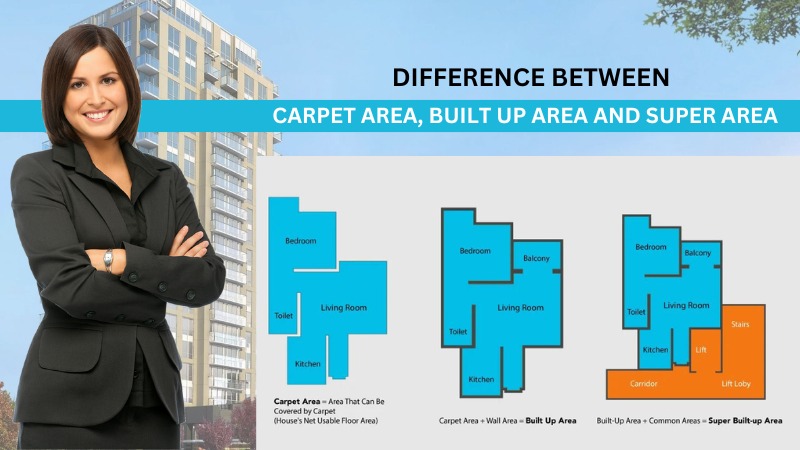Table of Contents
The terms carpet area, built-up area, and super area are commonly used in real estate and construction industries to describe the different measurements of a property. In this response, we will explain the differences between these three terms in detail.
Carpet Area
The carpet area is the net usable area within the walls of a property. It is the area that can be covered by a carpet or rug. This area does not include the thickness of the walls, balcony, or terrace. In simpler terms, carpet area refers to the actual area where you can lay down a carpet and use it.
Carpet area is calculated by measuring the internal dimensions of a room, excluding areas such as external walls, internal walls, balconies, and terraces. This area is important to measure the actual usable area of the property. It helps in deciding the space and layout of the furniture and appliances.
Carpet area is a crucial factor in determining the value of a property. The higher the carpet area, the higher the value of the property.
What is the RERA carpet area?
RERA carpet area refers to the actual usable area within a property that is available for the occupant to use. It is defined by the Real Estate (Regulation and Development) Act (RERA) in India and is used to ensure transparency in the real estate sector. The RERA Act mandates that builders must disclose the carpet area of a property to buyers and renters. The carpet area excludes common areas such as lobbies, stairs, elevators, and corridors. By knowing the RERA carpet area of a property, buyers and renters can ensure that they are paying for the actual usable area of the property.
How to Calculate Carpet Area?
The carpet area is the actual usable area within a property that is available for the occupant to use. It is calculated by measuring the length and width of each room and multiplying them to get the area of each room. Then, the areas of all the rooms are added up to get the total carpet area of the property.
Here are the steps to calculate carpet area:
- Measure the length and width of each room: Use a tape measure to measure the length and width of each room in the property. Make sure to measure from the inside of the walls to get an accurate measurement.
- Multiply length and width to get the area of each room: Once you have the measurements for each room, multiply the length and width of each room to get the area of each room. For example, if a room is 10 feet by 12 feet, the area of the room would be 120 square feet (10 x 12 = 120).
- Add up the areas of all the rooms: After calculating the area of each room, add up the areas of all the rooms to get the total carpet area of the property. This will give you a clear idea of the actual usable area within the property.
It’s important to note that the carpet area excludes common areas such as lobbies, stairs, elevators, and corridors. This means that the carpet area of a property is usually less than the built-up area or super area, which includes common areas and walls.
Calculating carpet area can be useful when buying or renting a property to ensure that you are paying for the actual usable area. It can also be used to calculate the cost of the property and the amount of taxes and fees that may be applicable.
In some cases, it may be difficult to calculate the carpet area of a property on your own, especially if the property has irregular shapes or includes features such as balconies or terraces. In such cases, it may be necessary to consult with a professional or use specialized software to calculate the carpet area accurately.
Important things to keep in mind about the carpet area
Here are some important things to keep in mind about the carpet areas:
- It is the actual usable area: Carpet area refers to the actual usable area within a property that is available for the occupant to use. It does not include common areas such as lobbies, stairs, elevators, and corridors.
- It is different from the built-up and super area: The carpet area is usually less than the built-up area or super area, which includes common areas and walls.
- It is important to know when buying or renting a property: Knowing the carpet area of a property can help you understand the actual usable area you will have available and ensure that you are paying for the actual usable area.
- It can affect the cost of the property: Since the carpet area is the actual usable area, it can affect the cost of the property. Properties with larger carpet areas will generally be more expensive than those with smaller carpet areas, all else being equal.
- It is regulated in some countries: In some countries, such as India, the Real Estate (Regulation and Development) Act (RERA) mandates that builders must disclose the carpet area of a property to buyers and renters.
- It can be difficult to calculate: Calculating the carpet area of a property can be difficult, especially if the property has irregular shapes or includes features such as balconies or terraces.
- It can be useful for tax purposes: The carpet area of a property can be used to calculate the amount of taxes and fees that may be applicable.
In summary, understanding carpet area is important when buying or renting a property, as it represents the actual usable area that will be available to you. It is different from the built-up and super area and can affect the cost of the property. While calculating the carpet area can be difficult, it is regulated in some countries and can be useful for tax purposes.
Built-Up Area
The built-up area is the carpet area plus the thickness of the walls, balconies, and terraces. It is the total area that is built up in a property, including the carpet area. The built-up area is typically 10-20% more than the carpet area. It is also known as the plinth area or the covered area.
The built-up area includes the carpet area as well as the area of the walls, balconies, and other areas that are covered by the roof or the walls. It is important to note that the built-up area does not include the common areas of the building, such as the lobby, lifts, or staircases.
Built-up area is used to calculate the cost of construction and to estimate the price of the property. The cost of construction is calculated on a per-square-foot basis, and the built-up area is used to determine the total cost of construction.
Important Things About Built Up Area
Here are some important things to keep in mind about the built-up area:
- It includes common areas: Built-up area includes the carpet area as well as the area of common spaces such as lobbies, corridors, elevators, staircases, and other shared amenities.
- It is different from carpet area: While carpet area refers only to the usable area within a property, the built-up area includes both usable and common areas.
- It is usually more than the carpet area: The built-up area is generally more than the carpet area since it includes common areas and spaces such as walls.
- It affects the cost of the property: Since the built-up area is more than the carpet area, properties with larger built-up areas will generally be more expensive than those with smaller built-up areas, all else being equal.
- It can be regulated: In some countries, such as India, the Real Estate (Regulation and Development) Act (RERA) mandates that builders must disclose the carpet area as well as the built-up area of a property to buyers and renters.
- It is important to know when buying or renting a property: Knowing the built-up area of a property can help you understand the total area you will be paying for, including both usable and common areas.
- It can be useful for tax purposes: The built-up area of a property can be used to calculate the amount of taxes and fees that may be applicable.
In summary, understanding built-up areas is important when buying or renting a property, as it represents the total area you will be paying for, including both usable and common areas. It is different from carpet area, affects the cost of the property, and can be regulated in some countries. Knowing the built-up area can also be useful for tax purposes.
Super Area
The super area is the sum of the built-up area and a proportionate share of the common areas of the building, such as the lobby, lifts, and staircases. It is also known as the saleable area, and it includes the built-up area and the common area.
The super area is the total area of the apartment that a buyer pays for, including the built-up area and the common area. It is important to note that the common areas are distributed among all the apartments in the building based on the size of the apartment.
The super area is used to calculate the price of the property. The price per square foot is calculated based on the super area, which includes the built-up area and the common area.
What is the Loading Factor?
The loading factor is a term that is typically used to describe the ratio of rentable area to gross area in a commercial building. The gross area of a building includes all of the floor space within the building, including common areas such as hallways, lobbies, and restrooms. The rentable area, on the other hand, is the area within the building that can be rented to tenants for their exclusive use.
The loading factor is calculated by dividing the rentable area of a building by its gross area. This factor accounts for the shared spaces in a building and can affect the amount of rentable space available to tenants. For example, if a building has a loading factor of 1.2, this means that 20% of the gross area is taken up by shared spaces and cannot be rented out to tenants.
In commercial real estate, the loading factor is an important factor to consider when determining the amount of rentable space available within a building and can have a significant impact on the amount of rent that can be charged.
Formula to Calculate Loading Factor
The formula to calculate the loading factor is:
Loading Factor = Rentable Area / Gross Area
Where:
- Rentable Area: The area within a building that can be rented to tenants for their exclusive use.
- Gross Area: The total area of a building, including all of the floor space within the building, including common areas such as hallways, lobbies, and restrooms.
For example, if a building has a rentable area of 10,000 square feet and a gross area of 15,000 square feet, the loading factor would be:
Loading Factor = 10,000 / 15,000
Loading Factor = 0.67 or 67%
This means that 33% of the gross area is taken up by shared spaces and cannot be rented out to tenants.
What is covered in the Super Built-Up Area?
Super Built Up Area (SBUA) includes the carpet area of the individual unit plus the proportionate area of common areas like lobby, lifts, stairs, corridors, and other common amenities such as swimming pool, clubhouse, gymnasium, etc. that are available to all residents in the building.
The SBUA is typically calculated by adding a loading factor to the carpet area of the individual unit. The loading factor represents the proportionate share of common areas that are included in the SBUA.
It’s important to note that the SBUA is often used by developers and builders to advertise the size of a property, but it may not accurately reflect the actual usable space available to a buyer. Therefore, it’s essential to also consider the carpet area while evaluating the actual space available in a property.
Important Things about Super Built-Up Area
Here are some important things to know about Super Built-Up Area (SBUA):
- SBUA includes the carpet area of the individual unit plus the proportionate area of common areas.
- The loading factor is used to calculate the proportionate share of common areas that are included in the SBUA.
- The SBUA is often used by developers and builders to advertise the size of a property, but it may not accurately reflect the actual usable space available to a buyer.
- The carpet area is a more accurate reflection of the actual usable space available in a property.
- Buyers should ask for a detailed layout plan of the property to understand the actual usable area available.
- The SBUA is generally used to determine the maintenance charges that the residents have to pay to the society or the builder.
- The calculation of the loading factor and the determination of the SBUA may differ from one developer to another, and it’s important to clarify the basis of the calculation before making a purchase.
- In some states of India, the RERA (Real Estate Regulation and Development Act) mandates that the developer should disclose the carpet area of the property to the buyer, and the SBUA should not be used for advertising purposes.
- It’s important to be aware of the SBUA and the carpet area while evaluating the price of a property and comparing it with other properties in the same area.
Difference between Carpet Area, Built up Area and, Super Built-up Area
Carpet Area is the actual usable area inside a flat or a unit, which includes the area covered by walls but excludes common areas such as corridors, lifts, stairs, etc. It is the area where you can lay your carpet or rug, hence the name.
Built-up Area is the total area of the flat or the unit, including the carpet area, plus the area covered by walls and other fixtures such as balconies, cabinets, etc. It is the area covered by the built-up structure of the flat or unit.
Super Built-up Area is the total area of the flat or the unit, including the built-up area, plus the proportionate area of common spaces such as the lobby, lift, stairs, etc. It also includes amenities such as swimming pools, clubhouses, and other facilities shared by all residents of the building.
In simpler terms, Carpet Area is the actual usable area within your flat or unit, Built-up Area is the area covered by the built-up structure of your flat or unit, and Super Built-up Area is the Built-up area plus your share of the common areas and amenities of the building.
How the Calculation is done for Carpet Area, Built Up Area, and Super Built Up Area?
The calculation for Carpet Area, Built-up Area, and Super Built-up Area can be done using the following methods:
- Carpet Area: The Carpet Area is calculated by measuring the inner length and width of the apartment, from wall to wall, and multiplying them to get the total area. Any area covered by external walls, internal walls, and partitions is included in the Carpet Area.
- Built-up Area: The Built-up Area is calculated by adding the Carpet Area to the thickness of the walls, balconies, and other projections. This includes the area covered by internal and external walls, balconies, ducts, shafts, etc.
- Super Built-up Area: The Super Built-up Area is calculated by adding the Built-up Area to the proportionate share of the common areas such as the lobby, lift, staircase, etc. This also includes any amenities provided by the developer such as swimming pools, clubhouses, and other facilities shared by all residents of the building.
Carpet Area, Built-Up Area, and Super Built-Up Area: Indian Real Estate
Carpet Area, Built-Up Area, and Super Built-Up Area have commonly used terms in the Indian real estate industry. In India, these terms have legal definitions and are regulated by the Real Estate (Regulation and Development) Act, 2016 (RERA).
As per the RERA Act, Carpet Area is defined as the net usable floor area of an apartment, excluding the area of the external walls, balconies, and common areas. It is mandatory for developers to disclose the Carpet Area of the apartment in all advertisements and agreements.
Built-Up Area is defined as the Carpet Area plus the area occupied by the external walls, balconies, and other projections. This includes the area covered by internal and external walls, balconies, ducts, shafts, etc.
Super Built-Up Area is defined as the Built-up Area plus the proportionate share of common areas such as the lobby, lift, staircase, etc. This also includes any amenities provided by the developer such as swimming pools, clubhouses, and other facilities shared by all residents of the building.
Under the RERA Act, developers must disclose the Carpet Area, Built-up Area, and Super Built-up Area of the apartment in all advertisements and agreements. This helps buyers and investors to make informed decisions about the size, cost, and value of the property.
Common Mistakes Related to Carpet Area
Here are some common mistakes related to Carpet Area that people make:
- Assuming that Carpet Area is the same as Built-up Area or Super Built-up Area: Many people confuse Carpet Area with Built-up Area or Super Built-up Area and assume that they are the same. However, Carpet Area is the actual usable area within an apartment, while Built-up Area and Super Built-up Area include the area covered by the built-up structure and the proportionate share of common areas and amenities.
- Not verifying the actual Carpet Area before buying or renting a property: Sometimes, builders or developers may manipulate the Carpet Area by including the area covered by external walls or other spaces that are not actually usable by the buyer. It is important to verify the actual Carpet Area by measuring the inner length and width of the apartment from wall to wall.
- Not considering the Carpet Area while comparing different properties: Buyers and investors often compare properties based on the Built-up Area or Super Built-up Area without considering the Carpet Area. This can lead to incorrect comparisons and decisions as the Carpet Area directly affects the actual usable space within an apartment.
- Ignoring the impact of Carpet Area on the cost and value of the property: Carpet Area is a crucial factor that affects the cost and value of the property. A larger Carpet Area translates into more usable space and can increase the value of the property. On the other hand, a smaller Carpet Area may reduce the value of the property, even if the Built-up Area or Super Built-up Area is large.
In conclusion, carpet area, built-up area, and super area are three different measurements used to describe the size and value of a property. Carpet area is the actual usable area within the walls of a property. Built-up area is the carpet area plus the thickness of the walls, balconies, and terraces. Super area is the sum of the built-up area and a proportionate share of the common areas of the building. It is important to understand the differences between these terms when buying or selling a property to ensure that you are getting the best value for your money.
Suggestion: Noida Extension and Greater Noida Which is the Better Option
FAQs
1. What is carpet area?
Carpet area is the actual usable area within the walls of a property, excluding the thickness of the walls, balcony, or terrace.
2. What is built-up area?
Built-up area is the carpet area plus the thickness of the walls, balconies, and terraces.
3. What is super area?
Super area is the sum of the built-up area and a proportionate share of the common areas of the building.
4. Why is carpet area important?
Carpet area is important because it helps to determine the actual usable area of a property, which affects the value and cost of the property.
5. What is the difference between carpet area and built-up area?
The difference between carpet area and built-up area is that carpet area is the actual usable area within the walls of a property, while built-up area includes the thickness of the walls, balconies, and terraces.
6. What is the difference between built-up area and super area?
The difference between built-up area and super area is that built-up area includes the thickness of the walls, balconies, and terraces, while super area includes a proportionate share of the common areas of the building.
7. How is carpet area calculated?
Carpet area is calculated by measuring the internal dimensions of a room, excluding areas such as external walls, internal walls, balconies, and terraces.
8. How is built-up area calculated?
Built-up area is calculated by adding the thickness of the walls, balconies, and terraces to the carpet area.
9. How is super area calculated?
Super area is calculated by adding a proportionate share of the common areas of the building to the built-up area.
10. What are common areas in a building?
Common areas in a building are areas that are shared by all the residents, such as the lobby, lifts, staircases, and parking areas.
11. What is the difference between a super area and the saleable area?
The difference between the super area and the saleable area is that the saleable area includes the built-up area, the proportionate share of the common areas, and other charges such as external development charges, club membership fees, etc.
12. What is the importance of a built-up area?
Built-up area is important because it helps to calculate the cost of construction and estimate the price of the property.
13. What is the importance of the super area?
The super area is important because it helps to determine the total area of the apartment that a buyer pays for, including the built-up area and the common area.
14. Why is the super area larger than the built-up area?
The super area is larger than the built-up area because it includes a proportionate share of the common areas of the building.
15. What is the loading factor?
The loading factor is the percentage of the common area that is added to the built-up area to calculate the super area.
16. What is the carpet area to built-up area ratio?
The carpet area to built-up area ratio is the ratio of the carpet area to the built-up area. This ratio varies depending on the construction and design of the building.
17. What is the typical loading factor?
The typical loading factor is 25-30% of the built-up area, depending on the size and design of the building.
18. How does carpet area affect the value of a property?
The higher the carpet area, the higher the value of the property.
19. How does the built-up area affect the cost of construction?
The higher the built-up area, the higher the cost of construction.




